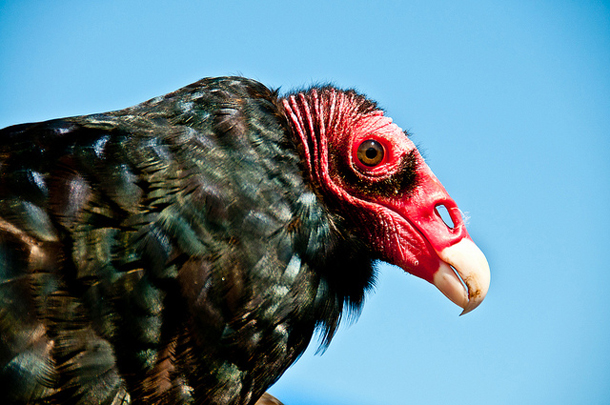BirdNote® What Do Birds Smell?
Air Date: Week of July 13, 2012
 |
It’s summer and that means it’s time to wake up and smell the roses. And, as BirdNote®’s Michael Stein reports, birds are doing a lot of sniffing this time of year.
Transcript
[BIRD NOTE® THEME]
GELLERMAN: They may be small and flighty - but don’t call them bird brains. Birds have mighty keen senses----and BirdNote®’s Michael Stein has a nose for a good story.
STEIN: Birds are justly renowned for their highly sensitive eyesight and hearing. Consider the exquisitely keen eye of the eagle, [Bald Eagle call] or the unerringly acute ear of the owl [A brief bit of Great Horned Owl calling]. But what about birds’ sense of smell? Among the many birds of the world, some are, without doubt, prodigious smellers.
[Ocean waves]
Diminutive seabirds called storm-petrels are olfactory savants – they can detect the scent of prey from a distance of 25 kilometers! The kiwis of New Zealand sniff the ground for earthworms
[Sniffing sound]
Before probing deeply to intercept their wiggly prey. Turkey Vultures also have a supremely keen sense of smell to lead them upwind from great distances to their malodorous feasts. Songbirds were long thought to have a poor sense of smell, because the olfactory center in their brains is proportionally tiny. However, current research suggests that some songbirds may use smell to find food, select prime nest material, and even help navigate across vast regions.
[Gray Catbird]
Experiments in the US with migratory Gray Catbirds show that, for adult birds repeating a migration route, sense of smell is more important than either orientation using the sun or using the earth’s magnetic field. It may well be that many songbirds “smell” their way back to last year’s nesting site. [Brief bit of Gray Catbird. I’m Michael Stein.
GELLERMAN: To see photos of some champion avian sniffers, follow your nose to our website at LOE dot org.
Links
BirdNote® What Do Birds Smell? was written by Bob Sundstrom.
Living on Earth wants to hear from you!
Living on Earth
62 Calef Highway, Suite 212
Lee, NH 03861
Telephone: 617-287-4121
E-mail: comments@loe.org
Newsletter [Click here]
Donate to Living on Earth!
Living on Earth is an independent media program and relies entirely on contributions from listeners and institutions supporting public service. Please donate now to preserve an independent environmental voice.
NewsletterLiving on Earth offers a weekly delivery of the show's rundown to your mailbox. Sign up for our newsletter today!
 Sailors For The Sea: Be the change you want to sea.
Sailors For The Sea: Be the change you want to sea.
 The Grantham Foundation for the Protection of the Environment: Committed to protecting and improving the health of the global environment.
The Grantham Foundation for the Protection of the Environment: Committed to protecting and improving the health of the global environment.
 Contribute to Living on Earth and receive, as our gift to you, an archival print of one of Mark Seth Lender's extraordinary wildlife photographs. Follow the link to see Mark's current collection of photographs.
Contribute to Living on Earth and receive, as our gift to you, an archival print of one of Mark Seth Lender's extraordinary wildlife photographs. Follow the link to see Mark's current collection of photographs.
 Buy a signed copy of Mark Seth Lender's book Smeagull the Seagull & support Living on Earth
Buy a signed copy of Mark Seth Lender's book Smeagull the Seagull & support Living on Earth

